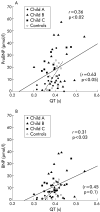Increased circulating pro-brain natriuretic peptide (proBNP) and brain natriuretic peptide (BNP) in patients with cirrhosis: relation to cardiovascular dysfunction and severity of disease
- PMID: 12970147
- PMCID: PMC1773816
- DOI: 10.1136/gut.52.10.1511
Increased circulating pro-brain natriuretic peptide (proBNP) and brain natriuretic peptide (BNP) in patients with cirrhosis: relation to cardiovascular dysfunction and severity of disease
Abstract
Background and aims: Cardiac dysfunction may be present in patients with cirrhosis. This study was undertaken to relate plasma concentrations of cardiac peptides reflecting early ventricular dysfunction (pro-brain natriuretic peptide (proBNP) and brain natriuretic peptide (BNP)) to markers of severity of liver disease, cardiac dysfunction, and hyperdynamic circulation in patients with cirrhosis.
Patients and methods: Circulating levels of proBNP and BNP were determined in 51 cirrhotic patients during a haemodynamic investigation.
Results: Plasma proBNP and BNP were significantly increased in cirrhotic patients (19 and 12 pmol/l, respectively) compared with age matched controls (14 and 6 pmol/l; p<0.02) and healthy subjects (<15 and <5.3 pmol/l; p<0.002). Circulating proBNP and BNP were closely correlated (r = 0.89, p<0.001), and the concentration ratio proBNP/BNP was similar to that of control subjects (1.8 v 2.3; NS). Circulating proBNP and BNP were related to severity of liver disease (Child score, serum albumin, coagulation factors 2, 7, and 10, and hepatic venous pressure gradient) and to markers of cardiac dysfunction (QT interval, heart rate, plasma volume) but not to indicators of the hyperdynamic circulation. Moreover, in multiple regression analysis, proBNP and BNP were also related to arterial carbon dioxide and oxygen tensions. The rate of hepatic disposal of proBNP and BNP was not significantly different in cirrhotic patients and controls.
Conclusion: Elevated circulating levels of proBNP and BNP in patients with cirrhosis most likely reflects increased cardiac ventricular generation of these peptides and thus indicates the presence of cardiac dysfunction, rather than being caused by the hyperdynamic circulatory changes found in these patients.
Figures



Comment in
-
Origins of cardiac dysfunction in cirrhosis.Gut. 2003 Oct;52(10):1392-4. doi: 10.1136/gut.52.10.1392. Gut. 2003. PMID: 12970127 Free PMC article. No abstract available.
Similar articles
-
Immunoreactive amino-terminal pro-brain natriuretic peptide (NT-PROBNP): a new marker of cardiac impairment.Clin Endocrinol (Oxf). 1997 Sep;47(3):287-96. doi: 10.1046/j.1365-2265.1997.2361058.x. Clin Endocrinol (Oxf). 1997. PMID: 9373449
-
BNP and N-terminal proBNP are both extracted in the normal kidney.Eur J Clin Invest. 2006 Jan;36(1):8-15. doi: 10.1111/j.1365-2362.2006.01594.x. Eur J Clin Invest. 2006. PMID: 16403004
-
Alternate circulating pro-B-type natriuretic peptide and B-type natriuretic peptide forms in the general population.J Am Coll Cardiol. 2007 Mar 20;49(11):1193-202. doi: 10.1016/j.jacc.2006.12.024. Epub 2007 Mar 6. J Am Coll Cardiol. 2007. PMID: 17367664
-
[Brain natriuretic peptide (BNP) and N-terminal-pro BNP in chronic haemodialysed renal failure].Arch Mal Coeur Vaiss. 2004 Sep;97(9):881-8. Arch Mal Coeur Vaiss. 2004. PMID: 15521481 Review. French.
-
[Clinical utility of the cardiac markers BNP and NT-proBNP].Acta Med Austriaca. 2004;31(4):144-51. Acta Med Austriaca. 2004. PMID: 15732251 Review. German.
Cited by
-
Natriuretic peptides: Diagnostic and therapeutic use.Indian J Endocrinol Metab. 2011 Oct;15 Suppl 4(Suppl4):S345-53. doi: 10.4103/2230-8210.86978. Indian J Endocrinol Metab. 2011. PMID: 22145138 Free PMC article.
-
Physiology and clinical significance of natriuretic hormones.Indian J Endocrinol Metab. 2013 Jan;17(1):83-90. doi: 10.4103/2230-8210.107869. Indian J Endocrinol Metab. 2013. PMID: 23776857 Free PMC article.
-
N-terminal pro-brain natriuretic peptide level as a screening tool for cardiac involvement in paediatric diseases of extracardiac origin.Clin Res Cardiol. 2011 Sep;100(9):723-30. doi: 10.1007/s00392-011-0317-0. Epub 2011 Apr 14. Clin Res Cardiol. 2011. PMID: 21487941 Review.
-
Cirrhotic Cardiomyopathy: A New Clinical Phenotype.Arq Bras Cardiol. 2017 Jun;108(6):564-568. doi: 10.5935/abc.20170066. Arq Bras Cardiol. 2017. PMID: 28699978 Free PMC article. Review. No abstract available.
-
Frequency and severity of cirrhotic cardiomyopathy and its possible relationship with bacterial endotoxemia.Dig Dis Sci. 2013 Oct;58(10):3029-36. doi: 10.1007/s10620-013-2693-y. Epub 2013 Aug 2. Dig Dis Sci. 2013. PMID: 23907333
References
-
- Schrier RW, Arroyo V, Bernardi M, et al. Peripheral artery vasodilatation hypotheses: a proposal for the initiation of renal sodium and water retention in cirrhosis. Hepatology 1988;8:1151–7. - PubMed
-
- Møller S, Henriksen JH. Circulatory abnormalities in cirrhosis with focus on neurohumoral aspects. Semin Nephrol 1997;17:505–19. - PubMed
-
- Naschitz JE, Slobodin G, Lewis RJ, et al. Heart diseases affecting the liver and liver diseases affecting the heart. Am Heart J 2000;140:111–20. - PubMed
-
- Estruch R, Fernandezsola J, Sacanella E, et al. Relationship between cardiomyopathy and liver disease in chronic alcoholism. Hepatology 1995;22:532–8. - PubMed
-
- Pozzi M, Carugo S, Boari G, et al. Evidence of functional and structural cardiac abnormalities in cirrhotic patients with and without ascites. Hepatology 1997;26:1131–7. - PubMed
Publication types
MeSH terms
Substances
LinkOut - more resources
Full Text Sources
Other Literature Sources
Medical
Miscellaneous
